| Author |
Message |
Craig Peters

|
 Posted: Tue 12 Mar, 2019 9:35 pm Post subject: Posted: Tue 12 Mar, 2019 9:35 pm Post subject: |
 |
|
Here's one of the lovely "Sempach"-type long swords. Notice the pommel does not sit squarely on the tang. I don't think this is a result of aging and deformation. As we have seen with a fair number of swords in this thread, the length of the cross' arms is lopsided, with the one to the viewer's left being shorter than the right.
Image from Vikverir.

|
|
  |
 |
|
Karl G
Location: Australia Joined: 25 Apr 2016
Posts: 66
|
 Posted: Wed 13 Mar, 2019 3:32 am Post subject: Posted: Wed 13 Mar, 2019 3:32 am Post subject: |
 |
|
|
Refreshing to see this thread.
|
|
   |
 |
Craig Peters

|
 Posted: Wed 13 Mar, 2019 4:21 am Post subject: Posted: Wed 13 Mar, 2019 4:21 am Post subject: |
 |
|
Here's a great example of a sword whose proportions offend many modern people's sense of aesthetics, again from the Musée de l'Armée. Despite being a two-handed sword from the length of its grip, the width of its cross looks better suited to a long sword. And, instead of having a broad blade in proportion to the hilt, the blade is narrow with a broad fuller. Clearly, this weapon will have surprisingly lively handling for its size, but few modern people would want to commission a reproduction of this sword "as is".
Image from Vikverir.

|
|
  |
 |
Kai Lawson

|
 Posted: Wed 13 Mar, 2019 9:35 am Post subject: Posted: Wed 13 Mar, 2019 9:35 am Post subject: |
 |
|
Narrower blades aren't very much my thing aesthetically, but I wouldn't change a thing on that entire hilt in the latest photo. I really like the look and lines of it. Additionally, I really like that lumpy little fellow from the Musée de l'Armée (posted 2/25). It has a simple charm that is appealing, while still looking perfectly serviceable and functional.
Thank you, Craig, for sharing these. I would be curious to see one of these swords that looks to be actually made irregularly faithfully reproduced, to see how big a visual impact the irregularities would have to a modern audience. I'm sure reactions would be mixed, but it might not be so bad if the piece had a nice grip, was polished and bright and not covered in flakes and rust pocks.
"And they crossed swords."
--William Goldman, alias S. Morgenstern
|
|
  |
 |
Craig Peters

|
 Posted: Thu 14 Mar, 2019 3:25 am Post subject: Posted: Thu 14 Mar, 2019 3:25 am Post subject: |
 |
|
One thing that one would have to consider is whether to commission what might be termed an "exacting reproduction" or "in-the-spirit-of" reproduction. Allow me to explain what I mean by this. An exacting reproduction is a reproduction that tries to faithfully reproduce a particular antique sword, including all of the sword's specific defects (save those caused by age) just the way the original sword appears. Such as replica is a facsimile of a real sword precisely as it is.
By contrast, an "in-the-spirit-of" reproduction is not so demanding. Rather than trying to accurately replicate details including flaws, the "in-the-spirit-of" reproduction is one that tries to capture authentic medieval craftsmanship and execute that on a reproduction sword. This might include things like doing freehand work on fullers; not necessarily having a strongly symmetrical blade shape, creating pommels that are a little rough around the edges yet still executed with skill; crosses with arms of different length or slightly differing shape; in short, closely reproducing many of the features seen on the swords seen in this thread. With an "in-the-spirit-of" reproduction, the precise "flaws" will not match the original because they are the result of the smith's work. Nevertheless, the reproduction sword would have a similar sort of aesthetic to genuine antique medieval swords.
|
|
  |
 |
Craig Peters

|
 Posted: Sat 16 Mar, 2019 12:06 am Post subject: Posted: Sat 16 Mar, 2019 12:06 am Post subject: |
 |
|
The Musée de l'Armée houses a sister sword to the now well-known Cluny long sword. Overall, this sword is one of the cleaner and more precisely executed swords in this thread—a good reminder that some medieval swords, particularly from the later Middle Ages (post 1300 AD or so) might by less eccentric and "rough-and-ready" than many of the swords in this thread. What I want to draw attention to is the cross. This is a good example of a long sword with a comparatively narrow cross, somewhat similar in slenderness to the XVI.a from Borringholm, sword #15 at the start of this thread. If you juxtapose the cross of this sword with the sword at Cluny, the image becomes striking.
As I look at these two swords more closely, it seems they may not exactly be sister swords. This sword looks to have a Type XVIII.b blade, whereas the Cluny sword looks a bit more like a XV.a. Either way, they're still somewhat similar in character.
Images from Vikverir.
Musée de l'Armée Sword


Cluny Sword

|
|
  |
 |
J.D. Crawford

|
 Posted: Sun 17 Mar, 2019 7:36 pm Post subject: Posted: Sun 17 Mar, 2019 7:36 pm Post subject: |
 |
|
|
I wonder how these disproportionate 'short cross' swords would hold up against Peter Johnson's geometric analysis. In 'Sword, form and thought' he mentions that Viking swords do not conform to his system. Yet they still look right in their own way. Or is it just what we're trained to expect?
|
|
   |
 |
Craig Peters

|
 Posted: Mon 18 Mar, 2019 9:57 pm Post subject: Posted: Mon 18 Mar, 2019 9:57 pm Post subject: |
 |
|
| Kai Lawson wrote: | | Narrower blades aren't very much my thing aesthetically, but I wouldn't change a thing on that entire hilt in the latest photo. I really like the look and lines of it. |
The other thing I notice about the guard (on the two-handed sword) is that some might find it ugly in terms of overall shape and form. it certainly is an example of the utilitarian, functional crosses without a strong visual aesthetic. However, this quality in many ways makes it quite "medieval".
|
|
  |
 |
Craig Peters

|
 Posted: Mon 18 Mar, 2019 10:13 pm Post subject: Posted: Mon 18 Mar, 2019 10:13 pm Post subject: |
 |
|
A nice photograph of a sword from the Museum of London, showing the hole where the tang passes through. I wonder how many people would tolerate something like this on a modern replica. ;-)
Images from Vikverir.


|
|
  |
 |
|
Karl G
Location: Australia Joined: 25 Apr 2016
Posts: 66
|
 Posted: Mon 18 Mar, 2019 10:26 pm Post subject: Posted: Mon 18 Mar, 2019 10:26 pm Post subject: |
 |
|
|
You will start a revolution if you keep this up Craig. Next thing will be folks not afraid to do edge parrying, cut seasoned wooden hafts and everything else swords dealt with but that offend modern sensibilities.
|
|
   |
 |
Craig Peters

|
 Posted: Tue 19 Mar, 2019 9:46 pm Post subject: Posted: Tue 19 Mar, 2019 9:46 pm Post subject: |
 |
|
This sword has parallels with one from the Musée de l'Armée long sword whose hilt furnishings seemed to belong to an earlier era. Notice the riser near the middle of the sword does not align well with the riser on the blade; on the contrary, it is skewed at a strange angle. And then there is the hole in the pommel for the tang...
Sword from the Museum of London. Images from Vikverir.
The sword to the left:



|
|
  |
 |
Craig Peters

|
 Posted: Tue 19 Mar, 2019 10:10 pm Post subject: Posted: Tue 19 Mar, 2019 10:10 pm Post subject: |
 |
|
This sword is an interesting study in style and proportions, particularly in the hilt. The grip appears comparatively short, suggesting not a lot of room for the hand, particularly for a man with larger hands who may need to clasp the pommel. What's also interesting is that the clubbed ends on the cross are quite obviously meant to be different in style, with the normal medieval cross guard arm having a wide end, while the knucklebow has a much more phallic shape. The pommel, too, is interesting; one has the impression that a deliberately narrow, slightly more oval shape was selected to fit with the overall shape of the hilt. It is likely that some modern maker might choose to make the pommel just a little bit fuller and rounder to give the neat uniformity seen on many modern reproductions, but I think it would be a mistake on a sword like this.
Sword from the Museum of London. Image from Vikverir.

|
|
  |
 |
|
Brian Moffatt
Location: Scotland Joined: 03 Nov 2007
Posts: 30
|
 Posted: Wed 20 Mar, 2019 1:04 am Post subject: Posted: Wed 20 Mar, 2019 1:04 am Post subject: |
 |
|
Merely an observation....
But since ones hand is not symmetrical, why should one assume that hilts and pommels ought to be symmetrical?
Even a double edged sword may have a leading and a trailing edge, and I have noted in some of the swords I have handled, that there is more wear on one edge than the other.
Further... in the dark, it may be preferable to some, to be able to tell "which way round" the blade is...
All speculation of course, but many of these are personal weapons, and so adapted to the tastes of the owners.
My own test when examining early weapons is to hold them with ones eyes closed. If it feels good, it often is.
Not infallible, but a good rule of thumb.
Beware... There are currently some good looking but awfully clumsy "medieval" swords about.
All the Best,
Brian Moffatt.
|
|
  |
 |
Craig Peters

|
 Posted: Thu 04 Apr, 2019 4:49 am Post subject: Posted: Thu 04 Apr, 2019 4:49 am Post subject: |
 |
|
Our first example in this thread that's from period art, rather than an antique sword. Someone should have informed the effigy maker of Thomas de Stapel, died circa 1371, that the cross on his long sword is altogether too small and inappropriate on a sword of war. ;-)
Hopefully, the number of examples in this thread alone should make it apparent that swords with narrow crosses, whether single handed or long, were not unheard of in the 14th and 15th centuries, and were undoubtedly more common than most modern sword enthusiasts realize.
Image from Effigies and Brasses.

|
|
  |
 |
|
Cornelis Tromp
Location: Holland Joined: 03 Jan 2010
Posts: 87
|
 Posted: Tue 09 Apr, 2019 5:53 am Post subject: Posted: Tue 09 Apr, 2019 5:53 am Post subject: |
 |
|
recess in the pommel not centered
 Attachment: 57.36 KB Attachment: 57.36 KB
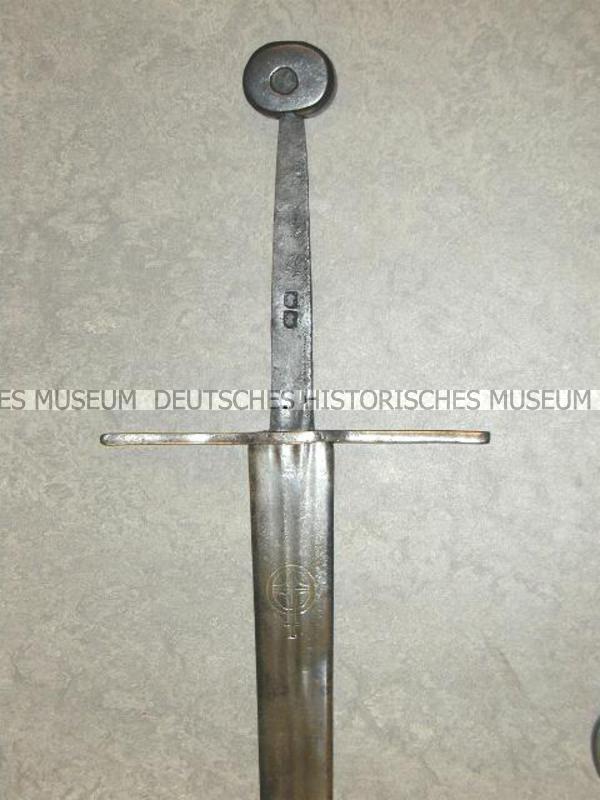
|
|
  |
 |
Craig Peters

|
 Posted: Tue 30 Apr, 2019 12:05 am Post subject: Posted: Tue 30 Apr, 2019 12:05 am Post subject: |
 |
|
This sword was one of those studied by Fabrice Cognot as part of his PhD. The left arm of the tang seems to be deformed. Fabrice suggests that this was caused by accident, although whether it was an accident of manufacture or some other form of accident is not clear to me. It's also worth noting that the tang seems to be warped and bends to the right.
What's also worth noticing is how thin and fragile the cross looks. Obviously, it has lot some material, and yet I do not think it was particularly thick or robust in the first place.
Photos by Fabrice Cognot.
 Attachment: 52 KB Attachment: 52 KB
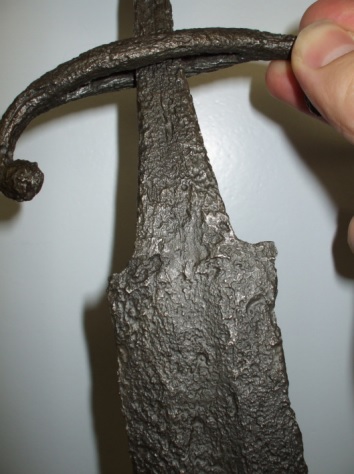
 Attachment: 32.06 KB Attachment: 32.06 KB
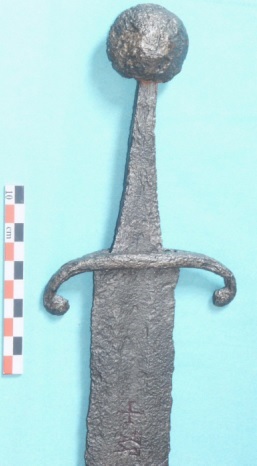
|
|
  |
 |
Craig Peters

|
 Posted: Tue 30 Apr, 2019 12:28 am Post subject: Posted: Tue 30 Apr, 2019 12:28 am Post subject: |
 |
|
Another from Fabrice Cognot's thesis, this time a Type XV sword. What's notable is that this sword has generally small dimensions overall. Perhaps some would suggest it is meant to be a boy's sword, although Fabrice does not. The overall length is only 86.5 cm. The width of the blade at the base of the sword is quite thin, at 4.3 cm, a dimension I'm not sure if I've ever seen on a reproduction sword. Also worthy of note is the incredibly short grip, which demands one grip the pommel when striking. As for the pommel itself, it is bent, though whether this is from age or deliberate design I cannot say.
Photos by Fabrice Cognot.
 Attachment: 28.78 KB Attachment: 28.78 KB
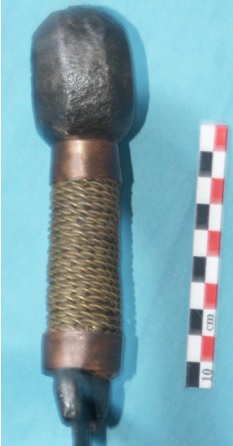
 Attachment: 37.23 KB Attachment: 37.23 KB
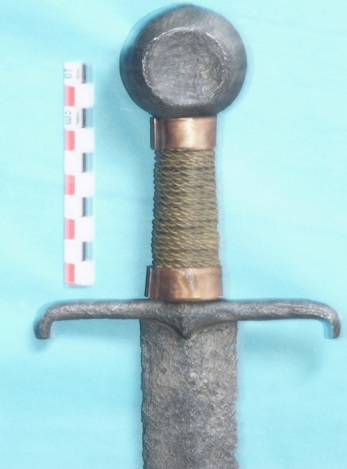
|
|
  |
 |
James Arlen Gillaspie
Industry Professional

Location: upstate NY Joined: 10 Nov 2005
Posts: 587
|
 Posted: Wed 08 May, 2019 9:44 am Post subject: Posted: Wed 08 May, 2019 9:44 am Post subject: |
 |
|
I may have said this before, but something to keep in mind is that modern swords are often made by means of stock removal (machining to shape) rather than using blacksmithing techniques, done at a bright orange heat or even a bit higher, and it is done very fast, which is good for production time but bad for precision. It is very difficult to act with precision or even to see clearly what one is doing when working on such hot metal, as the light it is emitting destroys many of the visual clues we get when looking at objects that reflect rather than emit light, and of course you have to strike while the iron is hot! This also explains why most helms are a bit wonky. The smith's main concern was, of course, that the weapons or armour work properly, and symmetry is not high on the list of priorities.
jamesarlen.com
|
|
   |
 |
Craig Peters

|
 Posted: Thu 30 May, 2019 3:18 am Post subject: Posted: Thu 30 May, 2019 3:18 am Post subject: |
 |
|
This is sword A-5693 from Iceland. Noteworthy is the asymmetric cross guard, which seems to be a deliberate design. Yet the style of the sword, which appears to be 13th or 14th century, is surprisingly early for a cross of this sort. Also odd is the tang's alignment with the blade. As you can see, it's far from being centered, and this seems to be part of the design as well. Peter Johnsson speculated this sword might have been a Type XII because much of the blade is missing, yet that means that the sword is not single-edged, something that could more easily explain the blade and hilt design.
Photo by Jóhann Gunnar Malmquist.
 Attachment: 67.32 KB Attachment: 67.32 KB
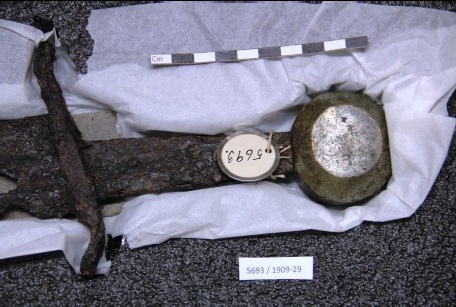
|
|
  |
 |
Craig Peters

|
 Posted: Thu 30 May, 2019 3:31 am Post subject: Posted: Thu 30 May, 2019 3:31 am Post subject: |
 |
|
Here's a fragmented long sword from Jagodina that has multiple eccentricities. The pommel's inner circle is far from perfect, and I don't think this is entirely because of corrosion or age. Notice how one side of the tang is nearly straight, while the other bulges significantly. Also noticeable is the fact that the left arm of the cross is at a steeper angle than the right. Last, notice how the fuller tends to wander a fair bit on this part of the blade.
Photograph by Branislav Cvetković.
 Attachment: 25.14 KB Attachment: 25.14 KB
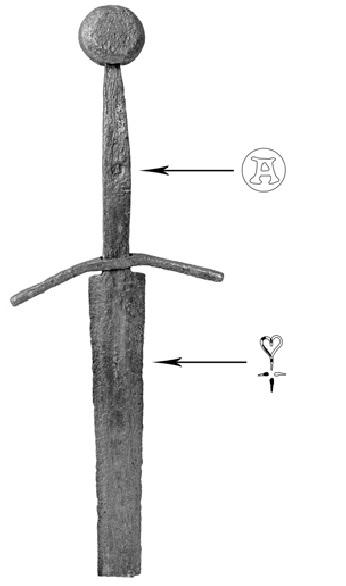
|
|
  |
 |
|
|

